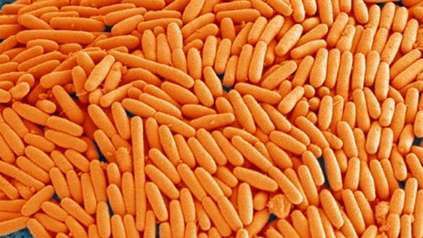New bacteria in mice associated with Inflammatory Bowel Disease
New disease-causing bacteria have been identified in the guts of laboratory mice.
Researchers from the Wellcome Sanger Institute, the Hudson Institute of Medical Research, Australia, the University of Cambridge and collaborators, have discovered and named two new strains of bacteria in the microbiome of mice that cause Inflammatory Bowel Disease (IBD) symptoms.
The study, published this month in Nature Microbiology, shows that the bacteria are commonly found in mice that are used to study IBD and could impact on the results of research into this condition. This shows that it is important to take into account the makeup of the gut microbiome when interpreting data. In the future, investigating whether there are similar strains found in the human gut could lead to further insight and treatment of IBD.
Inflammatory Bowel Disease, otherwise known as IBD, is a lifelong condition that impacts around 6.8 million people globally each year1. It occurs when there is chronic inflammation of the gastrointestinal tract and includes ulcerative colitis and Crohn’s disease1. IBD is considered a chronic condition, and when it flares up, it can cause debilitating symptoms that substantially reduce a patient’s quality of life.
While the exact cause of IBD is unknown, it has been suggested that in some individuals the immune system reacts to the naturally occurring bacteria in the gut, highlighting the importance of studying the microbiome in understanding and treating this condition.
In recent years, knowledge of the human microbiome has expanded extensively, but the equivalent investigations in mouse models have remained limited. Research into IBD relies heavily on using a mouse model known as the dextran sodium sulphate, or DSS, model to understand what is happening in the gut and the role of genetics in this condition.
While specific protocols have been established to control any effects that could be caused by known bacterial pathogens in the mouse microbiota, there is still a broad range of bacteria that need to be classified, identified and understood. It is important to understand the mouse microbiota and its impact on disease, in case this influences results and has implications for any further research.
In this latest publication, researchers studied around 600 mice from a single facility at the Wellcome Sanger Institute and analysed each microbiome in detail. This large-scale novel approach identified two new bacteria that were driving weight loss and intestinal inflammation in mice, and researchers named them Duncaniella muricolitica and Alistipes okayasuensis.
They found that D. muricolitica and A. okayasuensis are common bacteria in mouse colonies around the world by using data from previous work2 that catalogued 26,640 mouse microbiome bacteria.
As these bacteria cause IBD symptoms, they impact on the outcomes of mouse models for IBD studies. Researchers suggest this should be noted in designing studies and, if these bacteria are present, then interpretation of the results should take this into consideration.
“Mouse models are used widely to uncover more information on the development and treatment of Inflammatory Bowel Disease, however our research shows that the microbiome of these mice could impact on the results from these studies. While there are currently methods in place to reduce the impact of known disease-causing bacteria on studies, we have highlighted that there are bacteria that were previously unknown, and therefore not adjusted for. We hope that our research helps in the study design and interpretation of similar work in the future.”
Dr Samuel Forster, first author from the Hudson Institute of Medical Research, Australia
“The composition of the human gut microbiome is increasingly recognised as a key player in health and disease, especially in conditions such as Inflammatory Bowel Disease. To study this, we also require a more in-depth understanding of the mouse microbiome, including which bacteria are present, their interactions and how these differ across different mouse colonies and facilities. Our research begins to give new and critical insights into these factors.”
Dr Virginia Pedicord, co-senior author from the University of Cambridge
“Our large-scale study has identified two novel strains of bacteria that have shown to cause disease symptoms in mice. Now we are aware of these bacteria, we have a more informed view of the results that come from studies using these mouse models moving forward. This is important as around the world, scientists doing basic research, as well as biotechnological or pharmaceutical investigations of Inflammatory Bowel Disease, use mouse models to uncover new ways to prevent or treat this condition.”
Dr Trevor Lawley, co-senior author from the Wellcome Sanger Institute
More information
Notes to Editors:
- GBD 2017 Inflammatory Bowel Disease Collaborators. (2017) The global, regional, and national burden of inflammatory bowel disease in 195 countries and territories, 1990–2017: a systematic analysis for the Global Burden of Disease Study 2017. DOI:10.1016/S2468-1253(19)30333-4
- Beresford-Jones, S. Forster, M. Stares, et al. (2022) The Mouse Gastrointestinal Bacteria Catalogue enables translation between the mouse and human gut microbiotas via functional mapping. DOI: 10.1016/j.chom.2021.12.003
Publication:
S. Forster, S. Clare, B. Beresford-Jones, et al. (2022) Identification of gut microbial species linked with disease variability in a widely used mouse model of colitis. Nature Microbiology. DOI:10.1038/s41564-022-01094-z
Funding:
This research was funded by Wellcome, and the Australian National Health and Medical Research Council.



